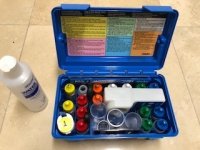- Jul 28, 2022
- 75
- Pool Size
- 18500
- Surface
- Vinyl
- Chlorine
- Salt Water Generator
- SWG Type
- Pentair Intellichlor IC-40
I was looking at the Taylor 2006c. On Amazon I see $127, but on their actual website I see $225. Is there a difference in products?



Just curious, why did you buy the Taylor kit over the Tf-Pro?I have gotten stuck with old product from Amazon. I just send it back. Happened twice one time. I just keep sending them back until I get a fresh one.
I had originally purchased the K-2006 and don't regret it. It has the smaller 3/4oz reagents, and a much smaller box. Some of the original reagents I never used (acid demand), so the smaller vials weren't as much of a waste. The ones I blow through I purchase 2oz reagents, keep those in a cupboard and refill the smaller vials as needed. The ones I barely use I replace with new 3/4oz vials. For CYA, I purchased a 16oz bottle and refill the two 3/4oz vials as needed. I believe this MO to be the most cost-effective one, as I would otherwise be tossing more unused reagents when the larger vials expire.
The smaller box is much easier to handle and fits where I need it to in my "pool cupboard." I figured out how to fit everything I need for testing in the smaller box, including my SpeedStir and two extra test vials plus the salt kit.
View attachment 481250 View attachment 481251
Tip 1: I align my reagents by order of use, first one in front, second one next, third in back, and label the caps with the number of drops to use, both of which helps my addled brain remember the instructions for each test without having to read the instructions label (which for some reason is getting smaller and smaller each year)!
Tip 2: I clip a couple of paperclips to the vial separators and stick my magnetic SpeedStir pills to them so that they stay put and dry well. That way I don't have to go digging around the box with my fat fingers to try and get them off the bottom.
Tip 3: Whenever I get one of those small desiccant packs (that come with vitamins or pills or electronics) I toss 'em in the kit, just for good measure.
View attachment 481252
PS. If you don't know what a SpeedStir is, buy one with your kit. It may sound extravagant, it is not. You'll test faster, more easily and much more accurately with one, and the first time you use it you'll thank us for recommending it.
The TF-pro wasn't available at the time. When he got his, the TF-100 and K-2006 were similarly priced and the 2006 had a nicer case. Now the K2006C costs well over the TF-100 and for $10 or so more the TFpro has an even nicer case and comes with the smart stir and is a no brainer.Just curious, why did you buy the Taylor kit over the Tf-Pro?
Print these out that some members worked onI do like the instructions on the Taylor 2006c box.
I don't now remember. Price maybe, at the time. They both use Taylor reagents, so you'll get the same test results.Just curious, why did you buy the Taylor kit over the Tf-Pro?
I see the replacement set of chemicals for the tf-pro, but I don’t see the salt replacement test chemicals?
I purchased the TF-100 first as I only had a basic kit from a pool store. Then as I was progressing with the TFP methodology, I purchased the basic small K-2006 (as did @Dirk ). I felt that since we recommend both that I should try both (the comparator is the main difference and the use of acid demand and base demand reagents) so I could understand any questions about one or the other.Just curious, why did you buy the Taylor kit over the Tf-Pro?

Yes and maybe no. I bought it on Amazon 2 years ago and it was sold and shipped directly from Taylor. It looks like that's from a different seller so you can't be sure how old it is.I was looking at the Taylor 2006c. On Amazon I see $127, but on their actual website I see $225. Is there a difference in products?
I purchase 2oz reagents, keep those in a cupboard and refill the smaller vials as needed.
I align my reagents by order of use, first one in front, second one next, third in back, and label the caps with the number of drops to use
That's good to know, but I have a tip for that, too! A tip tip: The tips in the 2oz reagents are the same as the tips in the 3/4oz size. I'll make a habit of swapping out the 3/4oz tips for the 2oz tips once in a while.FWIW, Taylor says the dropper tips eventually deform, so they recommend refilling no more than 8 times without replacing the tips.
Good catch. On some of my caps I actually have both test sizes labeled. CH is one. So on that cap I have 20 on one side, and 10 on the other side. Then on the next reagent, I have 5 on one side and 3 on the other. So I just have to remember to use either the higher numbers or the lower set of numbers.By the way, does the label on your R-0010 say "20"? What sample size do you use for CH testing?

